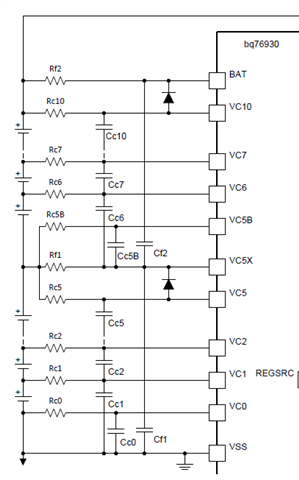Hi Team,
There is a interesting situation here: when Rc increase suddenly(from 1k to 56k), the voltage measurement will lost accuracy(lower or higher, nobody knows). And it should be noticed that the battery voltage remains constant, which is measured by a multimeter.

So, there are some questions as follow:
1. Is the voltage measurement achieved by detecting the current flowing into VCx? If yes, then the VC1/2/3/4/6/7/8/9 have both current flow out and flow in, what is the voltage measurement logic of BQ76930?
2. Is the voltage measurement of different battery cell synchronous or asynchronous?
3. Does the "Integrated cell balancing" works automatically?
4. If the accuracy is lost due to impedance matching, what should be the Rc range of the reference?
Thanks & Regards
Francis Jiang



